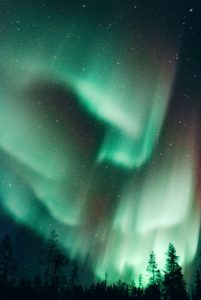
The first time I saw the Northern Lights on television, they mesmerized me: a shifting curtain of green and purple streaming from the sky, so of course, I had to put this in a pivotal scene in New Heights. Yet auroras are way cooler than I’d ever imagined! Here’s what I learned.
The term Aurora Borealis was coined from Aurora, the Greek goddess of the dawn, and Boreas, the god of the north wind, by Gallileo, the famous sixteenth-century astronomer who championed heliocentrism, the idea that the planets orbited the sun. These occur in high-latitude or Arctic regions; there are corresponding Southern Lights or Aurora Australis near the Antarctic.
High above Earth, charged particles, mainly protons and electrons from solar wind, precipitate into the atmosphere, and their trajectories are changed by the magnetic poles. The excitation of the particles emits light, much like the gas inside a neon sign when it interacts with electricity. Red auroras are the rarest, and occur at the highest altitudes. Most auroras are produced between 90-150 km above the earth, greens mainly attributed to oxygen ions and blue related to nitrogen.
Auroras tend to occur in auroral zones between ten and twenty degrees from the magnetic poles, though they can be seen further and are brighter during the equinoxes, March 20 and September 23, when the center of the sun is directly above the equator, or during geomagnetic storms related to solar flares. The last huge storm in 1859 produced light intense enough that one could read a newspaper outside at 1 a.m. At that time, the charged atmosphere disrupted telegraph communication for the most part but some of the lines were of the right orientation such that a geomagnetic current was induced. The New York Times documented a two-hour conversation between telegraph operators in Boston and Portland, who were able to shut down their battery power for over two hours, operating instead on the current from the aurora!
A phenomenon called aurora noise also occurs, which sounds like sizzling or crackling. This occurs at heights of 70 m above the earth, and is related to charged particles hitting an inversion layer on a cold night.
Auroras are tied to the eleven-year solar cycle, but nonetheless can be hard to predict. We may be coming into a new peak in the next year or two—in June, there was the biggest flare seen in eleven years. Certainly, I’ll be stepping onto my balcony at midnight on the 23rd, just in case.
Auroras used to be notoriously difficult to photograph, but digital cameras have made this easier. The phenomena occur in many forms, from a diffuse glow, to cloudlike patches, to arcs that ripple across the sky, sometimes appearing in stripes, to curtains.
The light displays have been interpreted by some Native Americans as signs their ancestors were happy, while some Australian people believed they were attempts at communication by ghosts, or evil spirits setting fire to the sky. The unusual appearance of the Aurora Borealis the night after the Battle of Fredericksburg in Virginia was taken by some in the Confederate Army that God was on their side. Some say the auroras are from light reflecting off the armor of the Valkyrie.
Is Earth the only planet with auroras? No, it isn’t—they’ve been seen on Jupiter, Saturn, Uranus, Neptune, Venus, and Mars, as well as the moon Io. Astronomers have even detected extra-solar auroras on the brown dwarf star LSR J1835+3259.
So that proves it: auroras really are out of this world!
Loved the content in this post. It was very informative and entertaining. Thanks!
Thank you! I was amazed, the more I found out!